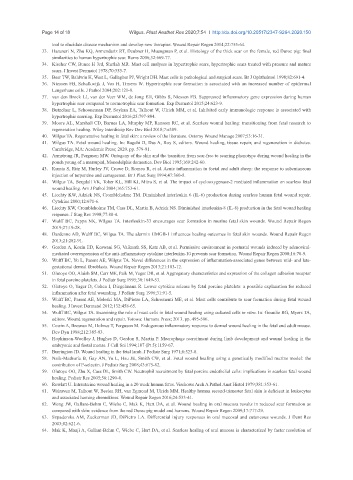Page 635 - Read Online
P. 635
Page 14 of 18 Wilgus. Plast Aesthet Res 2020;7:54 I http://dx.doi.org/10.20517/2347-9264.2020.150
tool to elucidate disease mechanism and develop new therapies. Wound Repair Regen 2014;22:755-64.
33. Harunari N, Zhu KQ, Armendariz RT, Deubner H, Muangman P, et al. Histology of the thick scar on the female, red Duroc pig: final
similarities to human hypertrophic scar. Burns 2006;32:669-77.
34. Kischer CW, Bunce H 3rd, Shetlah MR. Mast cell analyses in hypertrophic scars, hypertrophic scars treated with pressure and mature
scars. J Invest Dermatol 1978;70:355-7.
35. Beer TW, Baldwin H, West L, Gallagher PJ, Wright DH. Mast cells in pathological and surgical scars. Br J Ophthalmol 1998;82:691-4.
36. Niessen FB, Schalkwijk J, Vos H, Timens W. Hypertrophic scar formation is associated with an increased number of epidermal
Langerhans cells. J Pathol 2004;202:121-9.
37. van den Broek LJ, van der Veer WM, de Jong EH, Gibbs S, Niessen FB. Suppressed inflammatory gene expression during human
hypertrophic scar compared to normotrophic scar formation. Exp Dermatol 2015;24:623-9.
38. Butzelaar L, Schooneman DP, Soykan EA, Talhout W, Ulrich MM, et al. Inhibited early immunologic response is associated with
hypertrophic scarring. Exp Dermatol 2016;25:797-804.
39. Moore AL, Marshall CD, Barnes LA, Murphy MP, Ransom RC, et al. Scarless wound healing: transitioning from fetal research to
regenerative healing. Wiley Interdiscip Rev Dev Biol 2018;7:e309.
40. Wilgus TA. Regenerative healing in fetal skin: a review of the literature. Ostomy Wound Manage 2007;53:16-31.
41. Wilgus TA. Fetal wound healing. In: Bagchi D, Das A, Roy S, editors. Wound healing, tissue repair, and regeneration in diabetes.
Cambridge, MA: Academic Press; 2020. pp. 579-91.
42. Armstrong JR, Ferguson MW. Ontogeny of the skin and the transition from scar-free to scarring phenotype during wound healing in the
pouch young of a marsupial, Monodelphis domestica. Dev Biol 1995;169:242-60.
43. Kumta S, Ritz M, Hurley JV, Crowe D, Romeo R, et al. Acute inflammation in foetal and adult sheep: the response to subcutaneous
injection of turpentine and carrageenan. Br J Plast Surg 1994;47:360-8.
44. Wilgus TA, Bergdall VK, Tober KL, Hill KJ, Mitra S, et al. The impact of cyclooxygenase-2 mediated inflammation on scarless fetal
wound healing. Am J Pathol 2004;165:753-61.
45. Liechty KW, Adzick NS, Crombleholme TM. Diminished interleukin 6 (IL-6) production during scarless human fetal wound repair.
Cytokine 2000;12:671-6.
46. Liechty KW, Crombleholme TM, Cass DL, Martin B, Adzick NS. Diminished interleukin-8 (IL-8) production in the fetal wound healing
response. J Surg Res 1998;77:80-4.
47. Wulff BC, Pappa NK, Wilgus TA. Interleukin-33 encourages scar formation in murine fetal skin wounds. Wound Repair Regen
2019;27:19-28.
48. Dardenne AD, Wulff BC, Wilgus TA. The alarmin HMGB-1 influences healing outcomes in fetal skin wounds. Wound Repair Regen
2013;21:282-91.
49. Gordon A, Kozin ED, Keswani SG, Vaikunth SS, Katz AB, et al. Permissive environment in postnatal wounds induced by adenoviral-
mediated overexpression of the anti-inflammatory cytokine interleukin-10 prevents scar formation. Wound Repair Regen 2008;16:70-9.
50. Wulff BC, Yu L, Parent AE, Wilgus TA. Novel differences in the expression of inflammation-associated genes between mid- and late-
gestational dermal fibroblasts. Wound Repair Regen 2013;21:103-12.
51. Olutoye OO, Alaish SM, Carr ME, Paik M, Yager DR, et al. Aggregatory characteristics and expression of the collagen adhesion receptor
in fetal porcine platelets. J Pediatr Surg 1995;30:1649-53.
52. Olutoye O, Yager D, Cohen I, Diegelmann R. Lower cytokine release by fetal porcine platelets: a possible explanation for reduced
inflammation after fetal wounding. J Pediatr Surg 1996;31:91-5.
53. Wulff BC, Parent AE, Meleski MA, DiPietro LA, Schrementi ME, et al. Mast cells contribute to scar formation during fetal wound
healing. J Invest Dermatol 2012;132:458-65.
54. Wulff BC, Wilgus TA. Examining the role of mast cells in fetal wound healing using cultured cells in vitro. In: Gourdie RG, Myers TA,
editors. Wound regeneration and repair. Totowa: Humana Press; 2013. pp. 495-506.
55. Cowin A, Brosnan M, Holmes T, Ferguson M. Endogenous inflammatory response to dermal wound healing in the fetal and adult mouse.
Dev Dyn 1998;212:385-93.
56. Hopkinson-Woolley J, Hughes D, Gordon S, Martin P. Macrophage recruitment during limb development and wound healing in the
embryonic and foetal mouse. J Cell Sci 1994;107 (Pt 5):1159-67.
57. Burrington JD. Wound healing in the fetal lamb. J Pediatr Surg 1971;6:523-8.
58. Naik-Mathuria B, Gay AN, Yu L, Hsu JE, Smith CW, et al. Fetal wound healing using a genetically modified murine model: the
contribution of P-selectin. J Pediatr Surg 2008;43:675-82.
59. Olutoye OO, Zhu X, Cass DL, Smith CW. Neutrophil recruitment by fetal porcine endothelial cells: implications in scarless fetal wound
healing. Pediatr Res 2005;58:1290-4.
60. Rowlatt U. Intrauterine wound healing in a 20 week human fetus. Virchows Arch A Pathol Anat Histol 1979;381:353-61.
61. Walraven M, Talhout W, Beelen RH, van Egmond M, Ulrich MM. Healthy human second-trimester fetal skin is deficient in leukocytes
and associated homing chemokines. Wound Repair Regen 2016;24:533-41.
62. Wong JW, Gallant-Behm C, Wiebe C, Mak K, Hart DA, et al. Wound healing in oral mucosa results in reduced scar formation as
compared with skin: evidence from the red Duroc pig model and humans. Wound Repair Regen 2009;17:717-29.
63. Szpaderska AM, Zuckerman JD, DiPietro LA. Differential injury responses in oral mucosal and cutaneous wounds. J Dent Res
2003;82:621-6.
64. Mak K, Manji A, Gallant-Behm C, Wiebe C, Hart DA, et al. Scarless healing of oral mucosa is characterized by faster resolution of

